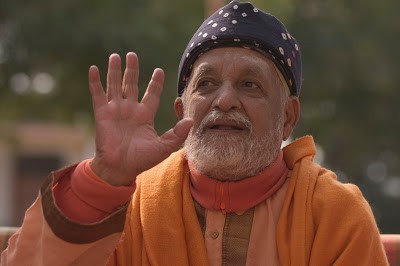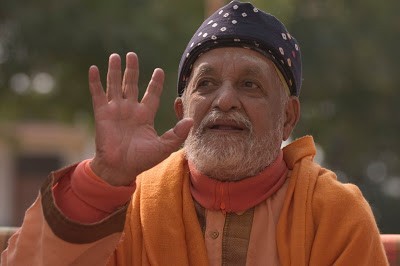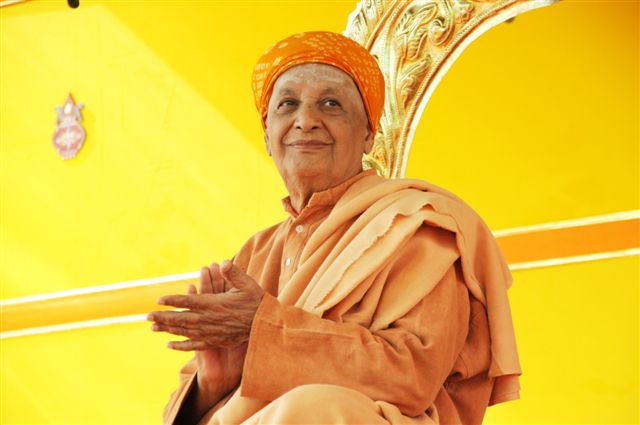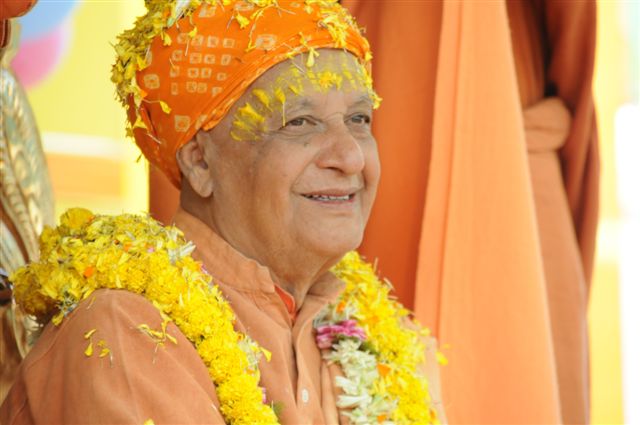
Satsang by Swami Satyananda
Just as people around the world observe All Saints Day or All Souls Day in India on Guru Poornima we celebrate All Gurus Day. Poornima is the full moon which represents the highest point of realization, when the light shines in absolute and utter darkness. Guru is the one who shines like the full moon on a dark night. Therefore, once a year, on the full moon of July, we get together and celebrate Guru Poornima and re-dedicate everything to guru.
We observe Guru Poornima each year in order to remind ourselves of our spiritual heritage and to re-establish our link with the higher forces that guide our evolution. Guru is the one who has completely transformed his consciousness. He lives in this world, but his spirit is always soaring in the highest dimension beyond space and time. Having completed his evolutionary cycle, there is nothing left for him to do but help raise the consciousness level of humanity.
The guru tradition is not a modern one; it is most ancient. Even before the advent of man, guru existed in the form of nature which guided the seasons, the plants and the animals. Prehistoric and stone age man had gurus; the animists, naturists and idolaters had gurus. Those who practised animal sacrifice, who believed in abstract gods, who wanted to learn magic, siddhis and witchcraft, had gurus. The guru tradition is not only confined to India. The Atlantis civilization had more gurus than any other civilization up to date. South America, Europe, Egypt, Mesopotamia, Tibet, China and Japan had gurus. Thousands of years ago there must have been Guru Poornima all over the world. The guru tradition is universal, but with so many wars and the ravages of time, it was gradually destroyed all over the world. No country was able to preserve it except India.
The guru-disciple relationship is surely one of the most significant aspects of human development. This relationship forms the basis of all cults, organizations and institutions, whether spiritual or otherwise. When we think about the great cultures that have flourished in the past, as well as those in existence today, we realize that they too are based on this same vital relationship. All the traditions, arts and sciences have been handed down generation after generation from guru to disciple, master to apprentice, father to son.
The guru-disciple relationship is man’s link with the higher faculties, the greater dimensions of his being. Without it, we would be hopelessly lost in the external world of diversities. It is only the saving grace of the gurus and masters which guides us back to the inner source from which all our higher potentials emanate. This is why the great teachers have always been regarded as the cornerstones of higher culture. Without their knowledge and inspiration, the traditions would not be enduring, the culture would not last.
In Indiawe consider the gurus and rishis from ancient times right up to the present day as the light and strength of our cultural heritage. What they taught and wrote in the Vedas, Upanishads and Tantras was not an empty philosophy, but a complete science of living. They encouraged the people to strive to fulfil their lives with abstinence, self-control, inner vision and self-knowledge. These qualities have a powerful influence on the whole society. If all the people were to cultivate them, you can well imagine the heights to which such a culture would rise. Indeed, it would become a virtual Utopia.
Our gurus and rishis had in their minds the creation of exactly such a culture. After thousands of years of experimentation, they came up with a system by which every individual could re-orientate himself and push open the doors of his perception. This is the science of yoga. Just as the potter fires his clay pots to make them strong, so yoga provides heat treatment for the vulnerable mind. It tempers and makes it strong enough to bear the upheavals of life.
Although the gurus envisioned an evolved human race, and knew that such a culture had once flourished throughout the world, they were unable to effectively introduce yoga into the society of their times due to the adverse political situations. So they remained in isolation and preserved the knowledge of this system for the time when mankind would again be ready for it.
This was the situation that prevailed right up to the twentieth century when the Age of Aquarius finally dawned. In this period, the rulership of the kings and monarch’s passed into the hands of the individual. As people were given more freedom to participate in the affairs of the community and state, they also began to assume more responsibility for their personal lives. At first, with the distribution of wealth and the coming of industrialization, people developed a more materialistic approach to life. But today this trend is rapidly reversing as more and more people become tired of materialism and look to yoga for a solution to their problems and a better way of life.
Now people are ready for yoga and the time is ripe for restoring the yogic culture. Many realized souls are now moving amongst the people and helping to make yoga more accessible by establishing yogashrams and centres around the world. Today we are witnessing the beginning of a great yogic renaissance. We are preparing for a gigantic leap forward in the evolution of mankind. Soon people everywhere will be practising yoga, and those who are not practising will at least know something about it. Guru Poornima will become an international festivity as men, women and children everywhere gather to dedicate themselves to the guru and to the coming of the yogic culture.
How does one find a guru?
Sometimes gurus are in search of disciples. Then the disciples do not have to worry because the guru will find them. This is a fact. But disciples are very impatient; they want the best guru, without understanding and knowing that they have to be the best disciple. A disciple can only get a guru according to his own development.
Where does the disciple stand? What is his spiritual attainment? What is the level of his detachment? Whether he is a beginner or he is advanced, accordingly, the guru will pick him up. Gurus keep wandering throughout the world in search of disciples. They do not search for disciples in order to increase their tribe. They are selfless souls inspired by higher inspiration, who want to help all those souls groping in avidya and darkness.
Please do not worry and waste your time searching for gurus. Maybe you will get the wrong material. It is better that you prepare yourself. Develop your detachment, improve your sincerity to the purpose, correct the order of your thinking and living, improve the quality of your concentration, and go to Satsang, kirtan, bhajan, pooja, swadhyaya, lectures and Gita discourses.
A guru must be a sadhaka. Even if he cannot sing or deliver lectures, even if he cannot interpret the Brahma Sutras and the Bhagavad Gita, he should be in a position of experience. If he has no experience, if he is just a logician, a person with intellect who can explain the scriptures, he is an Acharya, not a guru. People like Ramakrishna Paramahamsa, Ramana Maharishi or Anandamayi Ma, Kabir, Mirabai, Tukaram and Gyandev could tell you the nature of every type of reality, because they had experienced it by removing avidya. When Kabir died, his material body turned into flowers. When Mirabai left the body, she just transformed her physical form into light, she became jyoti. Chaitanya Mahaprabhu also transformed his body into light; he entered a temple and remained there.
One who has control over the tattwas, who has control over the samskaras, who can travel within himself and outside, who has been endowed with the vision of light, who can lose his consciousness with no fear of death – such a person is the guru.
Guru is a word composed of two letters, gu meaning darkness and ru meaning dispeller. Guru means dispeller of darkness. What is darkness? Avidya is darkness. We are all in darkness because we cannot see the light. What is the light? Atmajyoti, the self, is light.
So do not worry about how to find a guru. Let us become good disciples and then we shall find a guru. Gurus are born as gurus, disciples are born as disciples. If the guru is great, the disciples are also great. Don’t think that when disciples are promoted they become the guru. Disciples are never promoted to guru. My disciples may call me guru, but I am a disciple for all time because I was born a disciple and I shall remain a disciple. Disciples are those who evolve and come to a point of perfection. Gurus are those who descend with the particle of divinity from the higher realm of awareness to our plane of consciousness. Therefore, we remain disciples and they remain gurus.
Unless you have a guru, you cannot become a disciple. It is very clear as far as I am concerned. I am always a disciple to my guru and I cannot and will not become a guru because if a disciple is full of glory, he is greater than guru. If I become a guru, my ego will become as fat as a buffalo. The ego is the greatest enemy of a spiritual aspirant. “I am a great man” – this is a time bomb. “I am a guru” – this is a poison, a virus. “I am a disciple” – this is humility, this is simplicity, because if you consider yourself humbler than a blade of grass, you are nearer to yourself and to God, and much nearer to his creation. So I have always lived with the consciousness of a disciple because I am working as a medium or as an instrument for my guru.
How does one become a good disciple?
A great disciple is not a good disciple. There has to be total humility, egolessness, total submission, as if you don’t exist, as if you are a flute. A hollow bamboo can be made into a flute but there must be no knots at all. Only then can you produce a sweet melody. It is a sort of self-denial. As long as you exist, the guru cannot be in you. In order to allow him to function through you, you will have to empty yourself. And this process of emptying oneself is the only practice or sadhana that a disciple has to do. He need not practise hatha yoga, raja yoga, karma yoga or bhakti yoga, he has just to empty himself.
My Lord, before you, I do not exist. I cannot think. You think through me. I leave the choice of my life in your hands. This is the type of self-surrender, atma samarpan we call it. Self-surrender is the key to what we call higher knowledge. How long can you hold your head high if it is full of arrogance and ignorance, if it is full of conflict and duality? To rend this duality will take life after life.
Maybe your guru is not great. He may be an ordinary man. Maybe my guru was much more ordinary than I was, I don’t know, but when I emptied myself and surrendered myself completely in total humility and obeisance to him, things happened.
Guru represents two realities – the teacher and the permeating reality. Guru is a teacher and the indweller of your heart. As a teacher he can teach you and as an indweller of your heart he guides the steps and the passages of your evolution and fulfilment. Let things happen. Guru is the shepherd; if you let him, he will take care of you.
What are the dangers in spiritual life?
Throughout my life as a disciple I have observed many important points which are very dangerous in the life of a disciple. When I was living with my guru, Swami Sivananda, many of the swamis, including myself, often thought we knew more than he did. In fact, we believed that the growth and development of the institution was only taking place because of our efforts.
There was a lot of intellectualism in us and because of it none of us could approach our guru like a child. Once we brought this problem to him. We said, “Often we feel that we know more than you do, and there are times when we feel that you make mistakes.” Swamiji replied, “You are right.” That was his greatness and that was our mean mindedness.
When you become a disciple, either a lay disciple or a sannyasin disciple, and you have accepted a mantra from your guru, then it becomes very important that he lives in your heart like a constant light. By maintaining constant awareness of the guru, you will be able to develop the satguru, that guru who dwells within.




